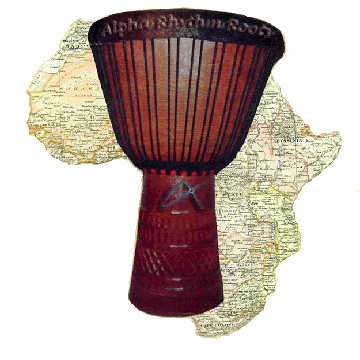The many ways to play the Doundoun set
- alpharhythmroots

- Jan 29, 2021
- 3 min read
Transferred from an older blog: Original post date by Alpha (Administrator) on 30/12/14
The Doundoun Set consists of three double-sided drums originated from the Mandingue in West Africa. These drums have different dimensions and pitch. The largest drum is the Doundounba which has a deep low pitch; the middle-sized drum is the Sangbeni or Sangban which has a middle low pitch sound; and the smallest is the Kenkeni which has the highest pitch.
Double-sided drums are played with a stick in a combination of open and closed notes. Closed notes (muffled sound) are achieved by leaving the stick on the skin of the drum, which stops the vibration of the skin, providing a different sounds from the open notes.
In a village / traditional setting, each of the three double-sided drums are usually played horizontally with one wooden stick, and with a bell attached to each drum. The bell is struck with a nail or a metallic ring put around the finger, while the other hand simultaneously play one side of the drum with the stick. The drums are strapped over the shoulder, allowing the players to carry the drum around, and facilitate any village ceremony, such as, playing while going/coming back from the fields during harvest.
A modern way of playing the Doundoun Set, inspired by the “Balai” (professional drum and dance ensembles) has more recently emerged in many Guinean cities. All three drums are attached together, and played at once by a single player in a vertical position using two wooden sticks.
An extra “separate Sangban” (played horizontally with a strap and bell) is also usually required in order to reproduce the full complexity of each piece of music (rhythm) as played in the original traditional village setting. The dance choreography matching the rhythms also often brings each dancer to play a single drum (Usually Sangban), in an upright position , or play the Sangban drum under the arm while dancing.
In another setting which is more common in the street, a single player would play only two of the three drums at once, stacked up on top of one another in an horizontal position, and together with a single bell and one striker.
While players in the traditional horizontal setting are usually only specialized in one of the three Doundouns, players from “Balai” modern way of playing rely on their skill and versatility. They would do whatever necessary to make sure all the rhythm voices are played, even if it means having to play one or two drums upright to complement whatever voices already being played.
The tuning of each drum in the orchestra is directly related to the rhythm (piece of music) being played and the other instruments played in the orchestra. Because the Doundoun set is the foundation of any rhythm, the tuning of each drum in relation to the other is very important, and whenever more than three drums are used, each player needs to make sure the symbiosis of all the drums in the orchestra is in line with the rhythm voices.
Depending on the region, ethnic group, or the rhythms played, not all three drums will be played. Because of the wide area that the Mandingue empire used to cover, and the centre being close to the Guinean north-east border with Mali, many Guinean rhythms are also played in Mali and other close countries such as Burkina Faso, Ivory coast, and Senegal.
There are some slight differences in the way the rhythm will be played according to the style of each region. For example, players in Mali tend to use only the two smallest Doundouns rather than three – Players in Burkina Faso tend to replicate the Doundoumba deep base on wider head Djembes.
If you would like to learn how to play the Doundoun, I strongly recommend that you start with the traditional horizontal way of playing all three Doundouns. I believe to begin playing rhythms the “Balai / modern” way first, is a terrible mistake!
Find a teacher who is well versed with this horizontal style of playing, and don’t be in a rush to play the modern upright way. Once you really understand all the voices of the three Doundoun for a specific rhythm, you will have no problem reproducing them in any mix playing setting, including “Balai / modern” style.
You can also read our other article entitled: “Purchasing the right Doundoun set for you”


Comments